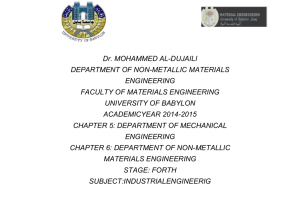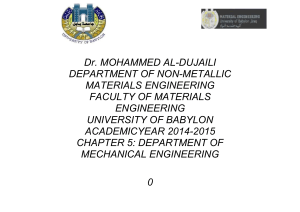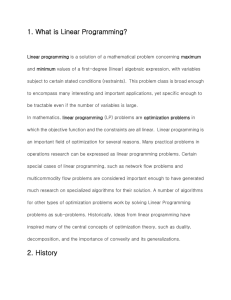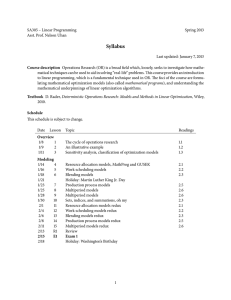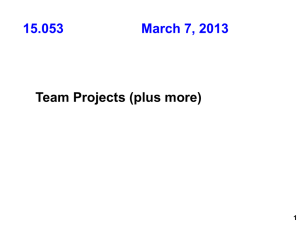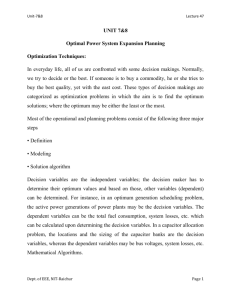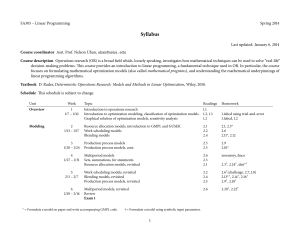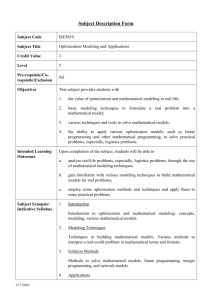pubdoc_3_8192_1565
advertisement
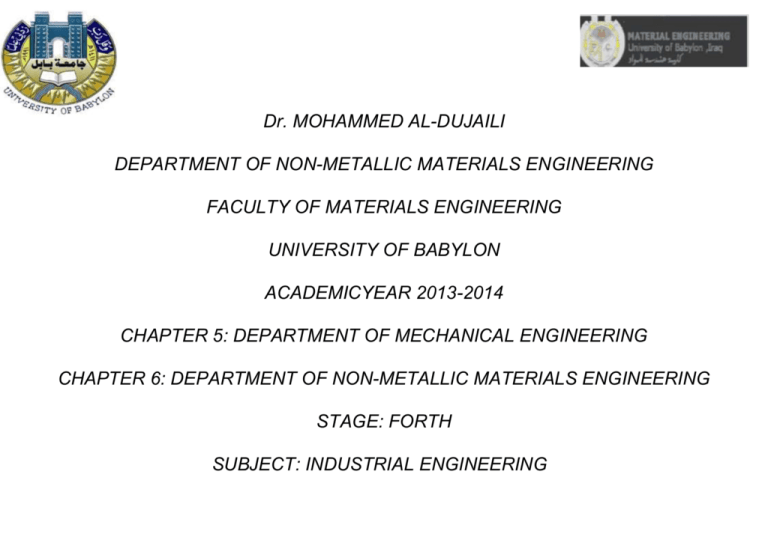
Dr. MOHAMMED AL-DUJAILI DEPARTMENT OF NON-METALLIC MATERIALS ENGINEERING FACULTY OF MATERIALS ENGINEERING UNIVERSITY OF BABYLON ACADEMICYEAR 2013-2014 CHAPTER 5: DEPARTMENT OF MECHANICAL ENGINEERING CHAPTER 6: DEPARTMENT OF NON-METALLIC MATERIALS ENGINEERING STAGE: FORTH SUBJECT: INDUSTRIAL ENGINEERING Linear Programming, Transportation Models and Maintenance Engineering Operation Research Engineering (ORE) ORE: is designed to provide a techniques and modeling concepts needed to analyze and design complex systems. That's mean, it is a discipline that deals with the application of advanced analytical methods to help make better decisions. It is often considered to be a sub-field of mathematics. Steps of operation research engineering A. Problem Definition B. Data Collection. C. Model Formulation D. Model Solution E. Validation and Analysis F. Implementation and Monitoring The following diagram explaining the steps of operation research. Problem Definition Data Collection Model Formulation - objective function - constraints Model Solution - mathematical method - Probability method -Simulation Diagram of the operation research steps Implementation of solutions the model Validation and the solution extracted extracted solutions classification 1.Linear Programming Linear programming (LP, or linear optimization) is a method to achieve the best outcome (such as maximum process or lowest cost) in a mathematical model whose requirements are represented by linear relationships. Linear programming is a special case of mathematical programming (mathematical optimization). More formally, linear programming is a technique for the optimization of a linear objective function, subject to linear equality and linear inequality constraints. It's feasible region is a convex polyhedron, which is a set defined as the intersection of finitely many half spaces, each of which is defined by a linear inequality. Its objective function is a real-valued affine function defined on this polyhedron. A linear programming algorithm finds a point in the polyhedron where this function has the smallest (or largest) value if such a point exists. - Linear programs are problems that can be expressed in canonical form: where x represents the vector of variables (to be determined), c and b are vectors of (known) coefficients, A is a (known) matrix of coefficients, and is the matrix transpose. The expression to be maximized or minimized is called the objective function (cTx in this case). The inequalities Ax ≤ b and x ≥ 0 are the constraints which specify a convex polytope over which the objective function is to be optimized. In this context, two vectors are comparable when they have the same dimensions. If every entry in the first is less-than or equal-to the corresponding entry in the second then we can say the first vector is less-than or equal-to the second vector. Linear programming can be applied to various fields of study. It is used in processes, but can also be utilized for some engineering problems. Industries that use linear programming models include transportation, energy, telecommunications, and manufacturing. It has proved useful in modeling diverse types of problems in planning, routing, scheduling, assignment, and design. - Standard form Standard form is the usual and most intuitive form of describing a linear programming problem. It consists of the following three parts: A linear function to be maximized e.g. Problem constraints of the following form e.g. Non-negative variables e.g. The problem is usually expressed in matrix form, and then becomes: - Augmented form (slack form) Linear programming problems must be converted into augmented form before being solved by the simplex algorithm. This form introduces nonnegative slack variables to replace inequalities with equalities in the constraints. The problems can then be written in the following block matrix form: Maximize Z: x, xs ≥ 0 where xs are the newly introduced slack variables, and Z is the variable to be maximized. Assumptions of linear programming 1. There are restrictions on the freedom of the use of resources and facilities available at the company as working hours or quantities of raw materials or semi-processed the plant or machinery. 2. Available several alternatives to a combination of resources and capabilities down to the goal sought by the involved company. 3. The relationships among the linear variables. 4. Provide the accuracy and reliability of the information and planning data, which will make the optimization decision in its light. Methods and techniques the linear programming 1.Graphical Method 2.Algebraic method 3.Simplex method 4.Transportation method 5.Assignment method
